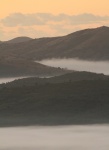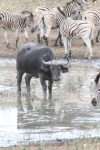Sorry for the delayed posting. My laptop’s battery exploded. For the third time since I got the computer. With no power source, I can’t post. Anyway, I’ve been asked from many people to describe my typical day. Well, there aren’t any ‘typical’ days, per se, so keep that grain of salt handy.
Every day out here is different. That’s one of the perks of living in the bush. You never know what animal may make an appearance and cause havoc in camp, what piece of equipment will fall apart, what personal drama one of the staff, or any of the students will thrust upon you to fix (and we’ve had everything from quickly flourishing to even more quickly broken romances, thievery, drug possession, injury from seriously bizarre accidents, family deaths, a false alarm mamba ‘bite’ – the excitement never ends). Even with strict rules, it seems humans can’t seem to help themselves when it comes to getting into trouble and doing exactly what they know they shouldn’t be doing. My job is, as much as I hate to admit it, essentially the camp mom for a large group of people who often don’t think rules apply to them because they paid to be here. Patience isn’t just a virtue out here; it’s a survival technique.
So as far as ‘normal’ goes, my normal day consists of an early wake-up (‘at sparrows’, as we say here) to what sounds like a chicken getting its head cut off. That lovely noise can be attributed to our resident francolins and spurfowls, also known as heart-attack birds for their habit of rustling in the bush hidden from view, grabbing your attention through an invisible scuffle and a shudder of underbrush, and then bursting out at you, screaming at the top of their lungs. You may remember I rescued a baby one of these a few posts back. The little ones don’t scream, they whistle. The big ones scream. And they usually start screaming at 4am, which is well before my wake-up call.
After initially bolting upright from the shock and reminding myself what is making that awful sound, I usually fall back to sleep for another two hours before waking to the more palatable sound of every bird within a ten-kilometer radius singing blithely. Funny, many birds make it a point to not be seen, but they ALL want to be heard. Except for the woodland kingfisher. When he’s around, he makes sure you know it on all fronts.
This brilliantly blue, white, and black bird has a bright orange beak and loves to sit on a tree branch just in front of my house, trilling away as loudly and as visibly as possible. He’s only around for half the year, though, so while I welcome him when he arrives, after a few days I almost can’t wait for him to migrate his ass on out of here.

My 2nd morning alarm clock, Mr. Woody Kingfisher
The only sound louder than the birds stem from my insect nemesis, which rolls into camp in summer and never fails to provide me with at least one or two migraines. When it’s summer, every other sound is drowned out by the cicadas, which are eardrum-destroying and always leave a horrible ringing noise in your ears for hours on end. I have very sensitive ears; I do not like the cicadas.
Anyway, I drag myself out of bed (yes, drag – sadly, I have never been a morning person, no matter how hard I’ve tried), turn on the shower, rinse off, assess the weather outside and dress myself in a few layers (knowing I will probably peel most of them off in a hour or so, so better to be prepared). I pack up my bag: keys, phone, eye drops for my ever-dry and dusty contacts, gum for my odd clean-tooth obsession, notebook, pen and camera – because you never know what you’ll see on the walk between my tent and camp. Oh, and sunglasses. Unless it’s actually raining, I never leave without the sunglasses. They are my best friend out here. The trifecta of my survival pack – sunglasses, suntan lotion and a mosquito net for the bed.
I always check the sand on the path outside my tent and on the way into camp for evidence of last night’s and this morning’s visitors, and spend most of the walk to camp with my head down, glued to signs on the ground. Usually all I see are the frantic circles of manic francolins, spurfowls, and pigeons, and often there are mongoose and monitor tracks, but every once in a while I see porcupine, hyena, and on good days, leopard. And of course snakes. Thankfully those are usually closer to camp. Except for the mamba, we actually don’t get snakes by our place very often, at least not that I know of, which is fine by me.
Once I get to camp, I set down the bag, hit the kitchen to say hello to the cook and cleaner, then go and tally up the previous day’s drinks. This is always a challenge, as they never seem to add up to the number of drinks actually missing from the fridge. Why and how people can’t count is beyond me. After some mathematical gymnastics, I refill the drinks, go to my ‘office’ and start up the camp laptop. Which usually won’t start because the generator isn’t on yet, and the computer battery doesn’t hold a charge. If I’m lucky, it has enough life to last until staff and students get back from their morning walk/drive. When that happens, I quickly say a prayer to the technology gods that the internet will ALSO actually work as I attempt to get online and pull up emails. Usually I lose that battle, which then prompts me to utter any combination of four-letter words under my breath, turn the machine off, and go back to the kitchen to help with breakfast.
Twice I week I sit down with the cook, plan a menu and put together food orders. Because of limited budgets, this often means getting creative, lest we eat the exact same thing every day, easy to do when you don’t have much money to work with and have to get permission to order things like yogurt because it’s ‘too expensive.’ I also help with cooking, always somewhat painful, since I really don’t enjoy cooking (probably due to my ‘need for approval’ complex and my desire to do things well, neither of which is ever satisfied when you stick me in a kitchen), nor am I any good at it, despite my best efforts. Our cook is a bit heavy-handed with things like oil and butter, so to prolong my life, and the lives of the people at camp, I often intervene to try and keep the artery clogging to a minimum. I usually get stuck with cutting up fruit, not so much of a challenge with apples and pears, but more of a mission when you add in mango and pineapple, particularly when the knives in camp are about as sharp as a baseball.
My normal cooking skills go towards satisfying the vegetarian/vegan/halal/kosher/gluten-free/every-other-allergen contingency, of which there are more than you would ever imagine. I’m always surprised that people with strict food issues choose to go to a bush camp in the middle of Africa and expect to have their dietary needs/choices satisfied in a place where white bread, fake cheese, potatoes and meat are all about the only things affordable AND available. Perhaps our marketing team sells them fairytales about what to expect? The conditions here seem pretty difficult to miss if you look at the brochures and read the marketing material, but whatever. All I know is I have to field the complaints about food all the time, even though there is almost nothing I can actually do about the situation. I can only limit the oil/butter/mayo added to dishes. With a fridge the size of a suitcase to house enough food to feed a few dozen people at any given time, two cabinets very easily accessible by rodents and insects, and the proclivity of our stocks to ‘grow feet’ anytime there is a staff changeover, I have to do what I can with what I have. Gourmet meals are NOT an option, not that people, especially the Americans and the Brits, don’t still expect them. The South Africans usually just want more meat, especially the South African guys. Again, I do what I can.
Anyway, breakfast is prepared, everyone returns to camp, breakfast is eaten, dishes are cleared, washed and put away, and I go back to do battle with the computer again, this time with a more positive attitude, since at least the generator is now on. If I still can’t get the internet to work, which is quite often, I will run errands, such as bringing the trash to the dump, washing laundry, reading up on some of the study materials, or sitting in on a lecture. That lasts for about an hour, after which I’m back to the kitchen to make sure lunch is getting started, or to marinate something for dinner. Three days a week our food orders arrive, so I recruit some students to come with me to the front gate, go through the food delivery and check it against our actual order, mark any errors, pack the food on the Land Rover and head back to camp, where we unload and put everything away. I then have to send the head office a note documenting any errors in the food orders, and follow up with the suppliers to find out what went wrong and why certain things were missing when I was told they were available, etc. Essentially all I do day in and day out is handle the problems in camp. There is nothing glamorous about my job. I’m the person everyone loves to hate. It’s awesome, let me tell ya. I’m the one responsible for making sure the wheels don’t fall off the bus, and I do it, despite the challenges, set-backs, and annoyances. But people being people, they complain about it. Some groups are worse than others. Some groups you’d like to see walk off into the sunset and get eaten by the local wildlife. Some groups are cool and make my job if not fun, at least tolerable.
My afternoon is spent sorting out lunch, any other myriad problems that come up (and the list for these is just endless), and getting dinner going. Then I try and duck away for an hour or so, go back to my room, turn on my iPod and attempt to get in a little exercise. My yoga mat is a sanity- and ass-saver out here. Or, if there isn’t an afternoon activity for the students, and it isn’t raining or the river isn’t flowing, we play volleyball in the riverbed. Actually, we do that sometimes when it’s raining too, depending on how heavily it’s coming down. That is my break for the day. Sometimes, if I’m lucky, I can sneak onto one of the afternoon game drives, my only opportunity to get out of camp.
If I don’t get to go out on a drive, at about 6pm, I shower and head back down to camp for dinner. Or I shower earlier and then head back to the kitchen to help COOK dinner (and yes, we DO have a cook we employ, but she feigns incompetence when students have strict dietary requirements and she has to make more of an effort). Mind you, she used to cook at a 5-star resort in one of the most exclusive bush camps in South Africa. I know better, and so does she, but to be honest, there isn’t much else to do, so I help.
After dinner, my fiancé and I sit at the table talking to some students, or we sit with them at the fire pit, but usually we just head back to the tent and go to sleep. It’s often the norm to be in bed by 9pm. When you have no electricity, you don’t have many other options. I don’t usually fall asleep until later, as I love listening to all the sounds at night. But eventually I drift off, and the next day starts the same way. On occasion, we get the excitement of a storm blowing through, which entails us (well, my fiancé, because I’m allergic to the canvas) running outside, pulling the canvas down over the shadecloth to close the tent up, and then frantically making sure we get everything off the floor as to avoid the inevitable floods that customarily inundate our home in the rains. Otherwise, everyone is snoring by 10pm. Exciting, I know. Welcome to the glamorous life of the bush.
-

-
My 2nd morning alarm clock, Mr. Woody Kingfisher
-

-
Dusk in Kruger
-

-

-

-

All rights reserved. ©2011 Jennifer Vitanzo

















